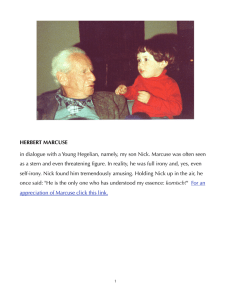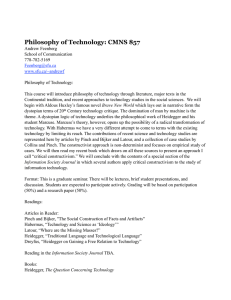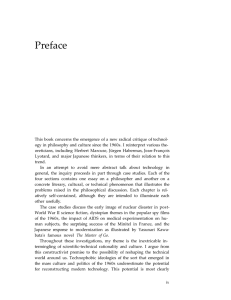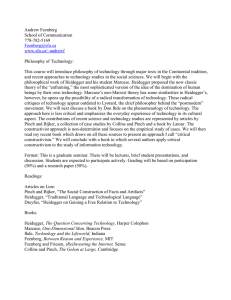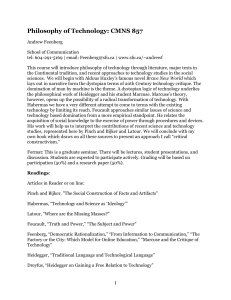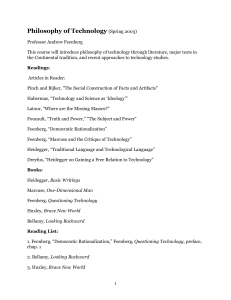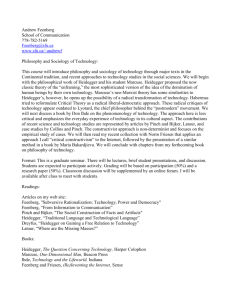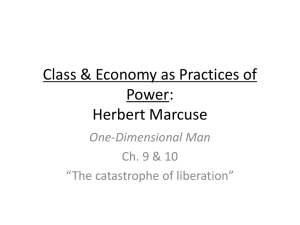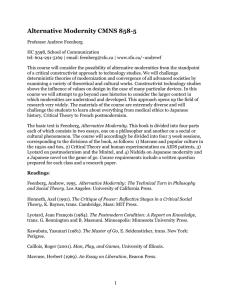Untangling Technology: Heidegger and Marcuse
advertisement
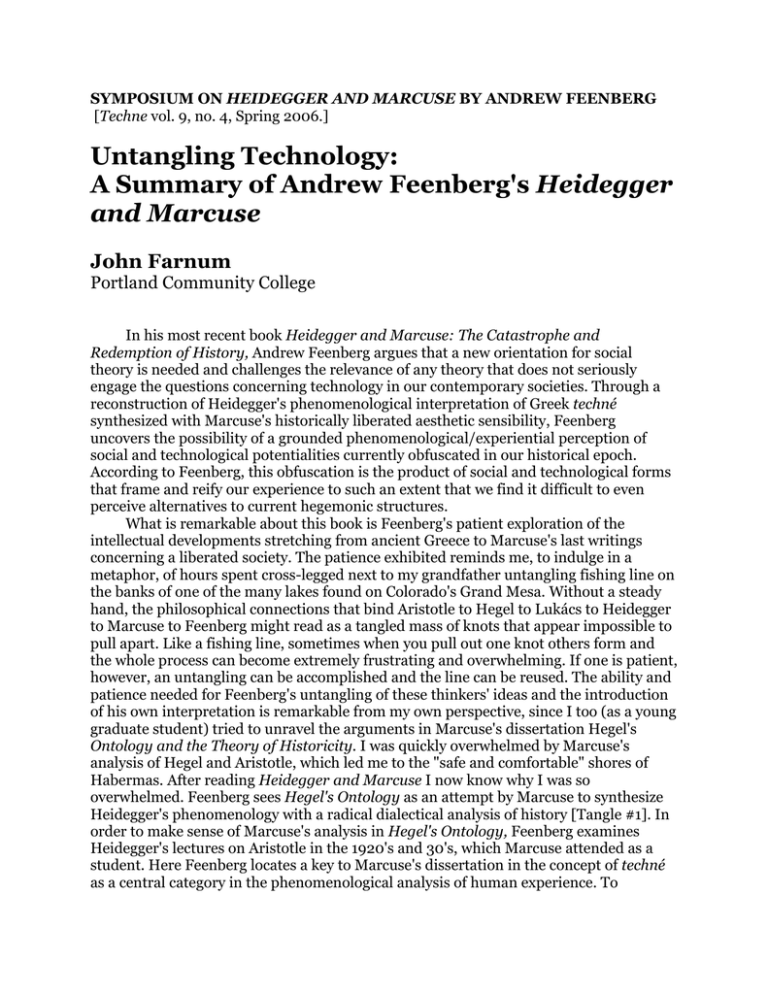
SYMPOSIUM ON HEIDEGGER AND MARCUSE BY ANDREW FEENBERG [Techne vol. 9, no. 4, Spring 2006.] Untangling Technology: A Summary of Andrew Feenberg's Heidegger and Marcuse John Farnum Portland Community College In his most recent book Heidegger and Marcuse: The Catastrophe and Redemption of History, Andrew Feenberg argues that a new orientation for social theory is needed and challenges the relevance of any theory that does not seriously engage the questions concerning technology in our contemporary societies. Through a reconstruction of Heidegger's phenomenological interpretation of Greek techné synthesized with Marcuse's historically liberated aesthetic sensibility, Feenberg uncovers the possibility of a grounded phenomenological/experiential perception of social and technological potentialities currently obfuscated in our historical epoch. According to Feenberg, this obfuscation is the product of social and technological forms that frame and reify our experience to such an extent that we find it difficult to even perceive alternatives to current hegemonic structures. What is remarkable about this book is Feenberg's patient exploration of the intellectual developments stretching from ancient Greece to Marcuse's last writings concerning a liberated society. The patience exhibited reminds me, to indulge in a metaphor, of hours spent cross-legged next to my grandfather untangling fishing line on the banks of one of the many lakes found on Colorado's Grand Mesa. Without a steady hand, the philosophical connections that bind Aristotle to Hegel to Lukács to Heidegger to Marcuse to Feenberg might read as a tangled mass of knots that appear impossible to pull apart. Like a fishing line, sometimes when you pull out one knot others form and the whole process can become extremely frustrating and overwhelming. If one is patient, however, an untangling can be accomplished and the line can be reused. The ability and patience needed for Feenberg's untangling of these thinkers' ideas and the introduction of his own interpretation is remarkable from my own perspective, since I too (as a young graduate student) tried to unravel the arguments in Marcuse's dissertation Hegel's Ontology and the Theory of Historicity. I was quickly overwhelmed by Marcuse's analysis of Hegel and Aristotle, which led me to the "safe and comfortable" shores of Habermas. After reading Heidegger and Marcuse I now know why I was so overwhelmed. Feenberg sees Hegel's Ontology as an attempt by Marcuse to synthesize Heidegger's phenomenology with a radical dialectical analysis of history [Tangle #1]. In order to make sense of Marcuse's analysis in Hegel's Ontology, Feenberg examines Heidegger's lectures on Aristotle in the 1920's and 30's, which Marcuse attended as a student. Here Feenberg locates a key to Marcuse's dissertation in the concept of techné as a central category in the phenomenological analysis of human experience. To understand Heidegger's interpretation of techné, Feenberg returns to ancient Greek philosophy and explains how the Greeks viewed nature as an interconnected part of any practical activity [Tangle #2]. When analyzing the potentiality of a practice, say of producing an artifact, a person has to work with and through the inner potentialities of a natural substance: "The craftsman is not the cause of the chalice in our sense at all, but a coresponsible agent in bringing the chalice into appearance" (17).1 The recognition of humans as dependent on and involved with nature is a nonhierarchical interactive realization of the human place in the natural world. In Heidegger's interpretation, the "world" unfolds as a set of possibilities that can be explored and nature becomes a set of potentialities that can be utilized for human ends. The disruption of this potentially harmonious relationship with nature occurs in the modern shift to an anthropocentric domination of nature as resource and raw material—which then turns everything, including ourselves into "standing reserves" for use in modern technological practices. Thus, as Feenberg explains, what the Greeks saw as the potential in nature to be shaped to human ends and goals is irreplaceably lost in our modern technological way of existing: "The technological enframing that takes its [the premodern understanding of techné] place does not so much create meanings as destroy them, de-worlding things and reducing them to a "objectless" heap. To the extent that it reveals meaning, what appears is an endless repetition of the same "standing reserve," Bestand, not the rich variety the Greeks found in their world" (43). This lost ability in modern times to recognize the potential of nature as a process of unfolding and revealing possibilities of living provides Heidegger with the gloomy prognostication that any hope is out of the hands of human agency and a radical reconstruction of existence can only occur through a quasidivine intervention of new forms of revealing being (45). Once we recognize the connection of techné to a Heideggerian revelation of potentialities, Feenberg argues that we can see Marcuse's attempts in Hegel's Ontology as a way of capturing this insight while also correcting Heidegger's ahistorical phenomenology through a historical account of being that utilizes a necessary Hegelian framework [Tangle #3]. For Marcuse, Hegel's emphasis on labor provides an essential link that enables a conceptual synthesis of history and phenomenology. When analyzing the structure of embodied historical existence, Marcuse explained that we are able to theoretically understand how human existence is primarily produced as an ontology of action: "Being, in its initial positing, produces itself as an existing being-there and drives itself onward toward higher forms of existence. Because this productive activity is historical and happens in the events that shape the human world, it involves human action" (67). Once humans realize that our activities produce our current horizon of being, we can recognize that the "chains" of our social structures are self-imposed. The next step takes us to Marcuse's encounter with Lukács [Tangle #4]. Marcuse borrows Lukács' theoretical efforts to transcend the reification that is present in modern forms of life dominated by capitalistic economic structures. Lukács provides Marcuse a theory of the modern forms of alienation that undermine the unity of the proletariat with being. The hope for Lukács is a proletarian revolution that would "disalienate" labor and provide a reunification of subject and object (worker and being) (75). The process outlined cannot merely be theoretical, but rather must occur at the most basic level of existence: human production. Lukács' hope for revolution becomes unrealistic for Marcuse in the midtwentieth century, which leads Marcuse on a search for a new ground for social critique [Tangle #5]. While Marcuse agrees that Lukács' diagnosis is correct and affirms the need for a grounded theory of human liberation, the sources of real transformation remain elusive in advanced industrial civilization. Marcuse's various attempts to ground social theory might be familiar to most readers and it is something I will leave Feenberg to explain in chapter 5 of Heidegger and Marcuse. Feenberg argues that the winding theoretically road Marcuse travels from his Hegelian/Marxist period (Reason and Revolution) to his Freudian period (Eros and Civilization) to his late turn to aesthetics (An Essay on Liberation) never provides an adequate ground to support a sufficient basis for critique. Here is where Feenberg takes a significant turn: Marcuse's theoretical projects needed the phenomenological resources of Heidegger in combination with a fuller version of an aesthetization of technology in order to address the problems faced in modernity. Feenberg thinks that this synthesis could have provided Marcuse with the theoretical and integrative ideal/practice of liberation that would have served as the ground for social critique. Ideally we would find a phenomenologically-based aesthetic that would divide values into life affirming and life oppressing, while practically those values would be instantiated into technological designs that liberate human sensibilities instead of repress them. Feenberg explains, Aesthetics here is not a matter of contemplation, but should be interpreted in classical terms as an ontological category. In its application to human affairs, it expresses the reflexive significance of the actors' actions for their existence. In the myth of the Islands of the Blessed that concludes the Gorgias, the naked souls of the dead are judged in their reality. So the Marcusian aesthetic evaluates naked societies, stripped of their self-congratulatory media images. A society where homelessness, urban squalor, prisons, and war are commonplace defines itself by these "actions" on terms we can reasonably condemn on aesthetic grounds in this classical sense (112). For Marcuse, this new aesthetic sensibility would provide the basis of a "civilizational politics" that would determine the direction and the look of historical change. What is at stake in this new concept of politics, according to Feenberg, is not political "power, laws, and institutions, but the very meaning of our humanity" (112). In the penultimate chapter of Heidegger and Marcuse, Feenberg unifies these insights by arguing for a modern interpretation of techné that Marcuse could have used to support his theoretical positions [Tangle #6]. The new idea of techné (stripped of the residue of ancient "essentialism") borrows the phenomenological framework of Heidegger's appropriation of Aristotle but retains the view of social emancipation Marcuse continually advocated. Phenomenology, according to Feenberg, provides an ontological framework to describe the interaction between human perception and nature that can recognize the potentialities latent in the process of creative activity: "A reciprocal interaction and exchange takes place joining maker and materials in a unity in diversity, a totality" (130). The resultant "harmony" between human and nature is a prerequisite for recognition of the potentialities inherent in the interactive process of production. A new form of perception can hopefully be developed that is currently missing in the dominating gaze of modernity. Coupled with the previously mentioned phenomenological insight is the critical social insight that current conditions are oppressive and could be changed to include more liberating designs and actualities: In a free society the universal element involved in all perception, the "concept" under which a "manifold" is unified, would incorporate an immediate awareness of the potentialities of the object. The object would be perceived through its concept, as it is today, but that concept would include a sense of "where the object is going," what it can become. The object to which these qualities are attributed is not the object of science. It is the lived experience of the world in which the perceived incompleteness and imperfection of things drives action forward (131). This active perception is most needed in our technological designs regarding nature. Feenberg argues we can't go back to nature, but rather we must go forward to a transformed future full of creative potentialities—a future that is currently concealed from view. REFERENCES Feenberg, Andrew. 2005. Heidegger and Marcuse: The Catastrophe and Redemption of History. New York: Routledge. Marcuse, Herbert. 1987. Hegel's Ontology and the Theory of Historicity. Trans. Seyla Benhabib. Cambridge, MA: MIT Press. END NOTES 11 All page citations are to Feenberg 2005.
